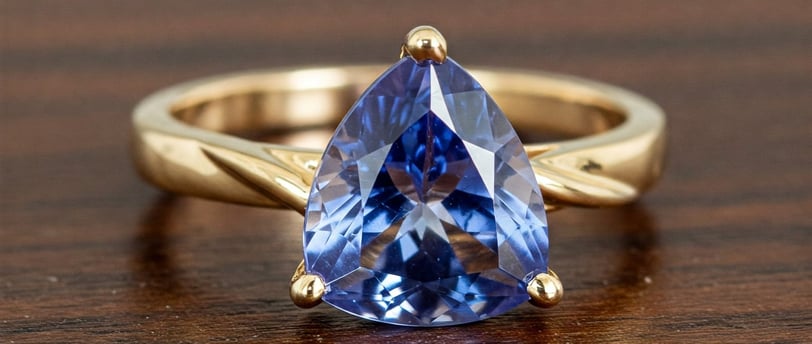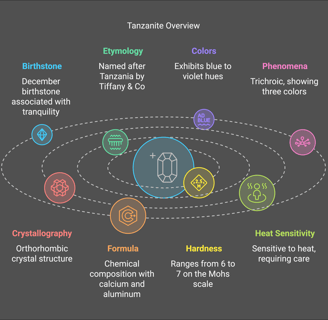Tanzanite
Tanzanite, a relatively recent discovery, has quickly risen in popularity among gem enthusiasts. This unique gemstone, known for its captivating blue and violet hues, is found in only one place on Earth, near Mount Kilimanjaro.
1/30/20254 min read


History
Tanzanite is a relatively recent addition to the world of gemstones, with its discovery only dating back to 1967. A Masai tribesman named Ali Juuyawatu is credited with finding the first tanzanite crystal. It was discovered in the Merelani Hills of northern Tanzania after a wildfire exposed the gem. The initial find was mistaken for sapphires by a merchant named Manuel D’Souza. It was later confirmed to be a unique gemstone, a blue variety of zoisite, by both the British Museum and Harvard University. Tiffany & Co. then named it tanzanite, after its country of origin. This gemstone has rapidly gained popularity in fine jewellery. Tanzanite is considered a modern option for the December birthstone. It is also the gem for a 24th wedding anniversary.
Mineral Origins
Tanzanite is a variety of the mineral zoisite. It is found exclusively in the Merelani Hills at the base of Mount Kilimanjaro in Tanzania. The deposits are located within a narrow strip of land about five miles wide. Tanzanite forms in calcareous rocks such as metamorphosed dolomites and calcareous shales subjected to regional metamorphism. The gem's unique blue to violet colour is a result of trace amounts of vanadium within the zoisite. It is a relatively rare gemstone.
The 4 C’s
Color
Tanzanite is known for its pleochroism, displaying different colours when viewed from different crystal directions. It is trichroic, which means it can show three colours: blue, purple, and brown. When fashioned, the gem usually displays a mix of blue and violet hues. Tanzanite's colours can range from a bright, intense blue to a violetish blue, with red flashes from within. The most prized colours are the intensely saturated violetish-blue to bluish-violet shades. In general, tanzanites with more blue are valued higher than those with more violet. Medium dark colours are considered ideal. Smaller stones often exhibit lighter colours, while larger stones above 5 carats are more likely to have the deep, saturated colours that are sought after. Tanzanite can appear blue in natural light and more violet in fluorescent light.
Clarity
Most tanzanites used in jewellery have inclusions that can only be seen under magnification. Any inclusions visible to the naked eye will decrease the value, particularly in lighter-coloured stones where the inclusions are more noticeable. Inclusions that pose durability problems, such as fractures, also lower the value. Some tanzanites may contain needle-like inclusions, which can sometimes produce a cat's eye effect.
Carat
Tanzanite is available in a variety of sizes, but the finest, deepest colours are typically seen in stones over 5 carats. Smaller stones are often less intense in colour. The price per carat increases significantly for smaller stones because of the rarity of good colour in these sizes. Large sizes of tanzanite do exist, with rough crystals weighing hundreds of carats being found.
Cut
Tanzanite is available in a variety of shapes, but cushion, trillion, and oval cuts are the most common. Cutters have to make choices about whether to cut for colour or for size, since cutting to emphasize the violet-to-purple colour usually results in less wasted rough. The cutter may choose a smaller top-colour gem over a larger, violet-purple one. Cutting orientation can also emphasize which colours are seen through the gem's crown. Deep cuts can enhance the tone of the gem. Because of tanzanite’s pleochroism, an experienced lapidary is required to maximize both the size and unique colour of the stone.
Be Aware Of
Enhancements
Virtually all tanzanite is heat-treated to achieve its stable blue to violet colour. Untreated tanzanite typically appears dull grey or brown. This heat treatment is considered a permanent enhancement that does not affect the price. There is no widely accepted method for confirming heat treatment. Some tanzanites may have surface coatings applied to improve colour and luster, or to add iridescence. These coatings tend to wear off the facet edges first.
Simulants
While no synthetic tanzanite exists, there are several simulants available. These include: synthetic forsterite, which can be identified by its doubled back facets and lower refractive index; synthetic yttrium aluminum garnet (YAG), also known as Tanavyte, which is harder than tanzanite and has a higher refractive index; synthetic corundum, such as Coranite, which appears grey-green under a Hanneman filter; and various kinds of glass, including colour-change glass. Most imitations can be identified with a Hanneman filter or by UV fluorescence.
Synthetics
Currently, there are no known synthetic tanzanites.
Final Thoughts
Buying Tips
When buying tanzanite, consider that a medium dark, slightly violet blue is the most desired colour. The stone should have good transparency and an intense colour. Be aware that the colour is less saturated in smaller sizes, and that stones above 5 carats are more likely to have a fine colour. Choose a stone with a good cut, which allows light to reflect evenly across the entire gem. Given tanzanite’s pleochroism, the cut will determine the face-up colour, so consider whether a more blue or more violet hue is preferred. It is always safe to assume that a blue to violet tanzanite has been heat-treated. It is also important to work with a knowledgeable jeweler who can show you quality differences.
Jewelry Care
Tanzanite has a hardness of 6 to 7, making it softer than many other gemstones. It also has a tendency to cleave and can be brittle. This means tanzanite is not the best choice for daily wear, especially in rings, and it requires a protective setting. For occasional wear, tanzanite is suitable for earrings, necklaces, and tie clips. When cleaning tanzanite jewelry, use only warm soapy water and a soft brush. Never put tanzanite in an ultrasonic machine or subject it to steam. Store tanzanite pieces in their own protective pouch to avoid scratching or chipping.


Gemius Stones
Expertise
© 2025. All rights reserved.
